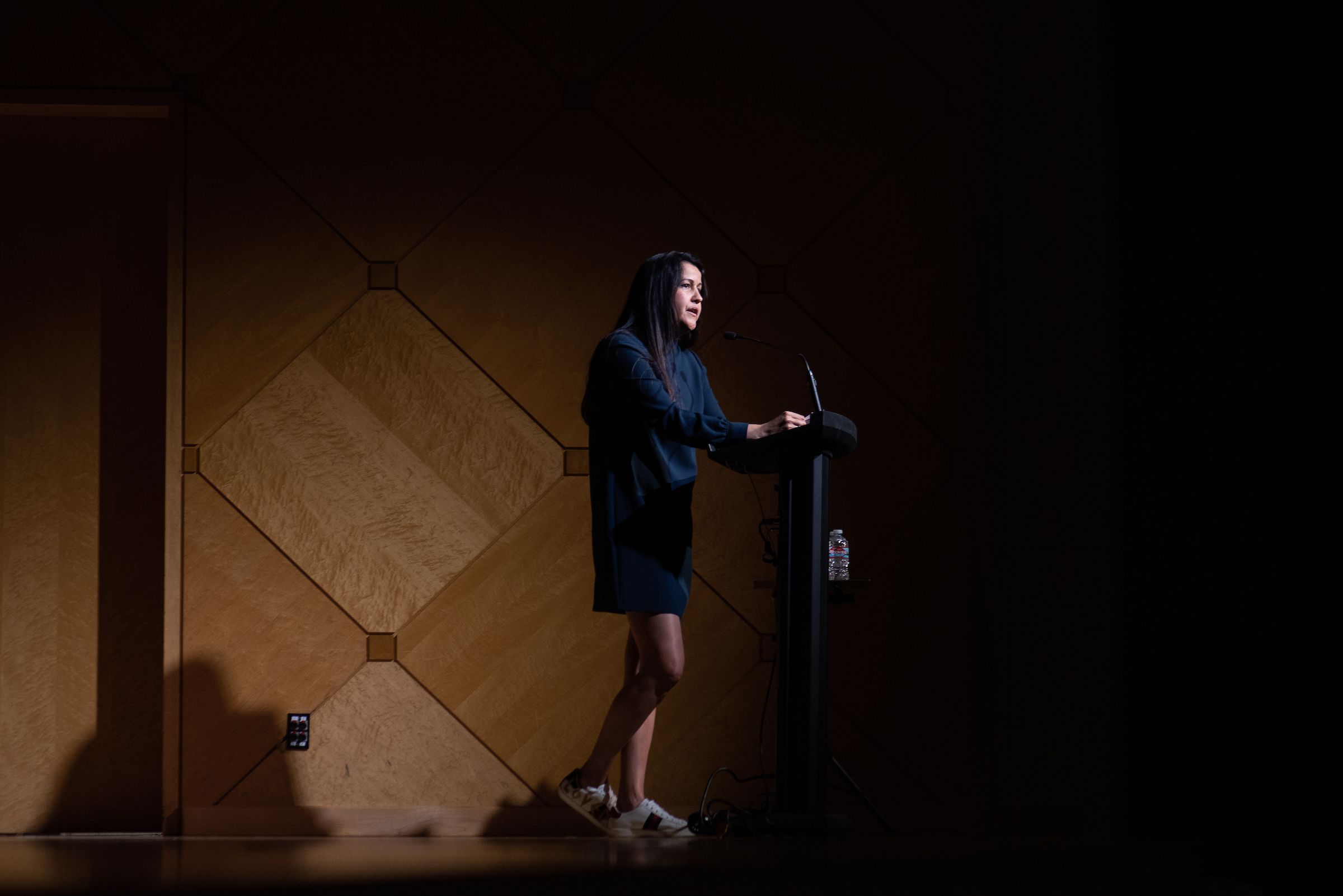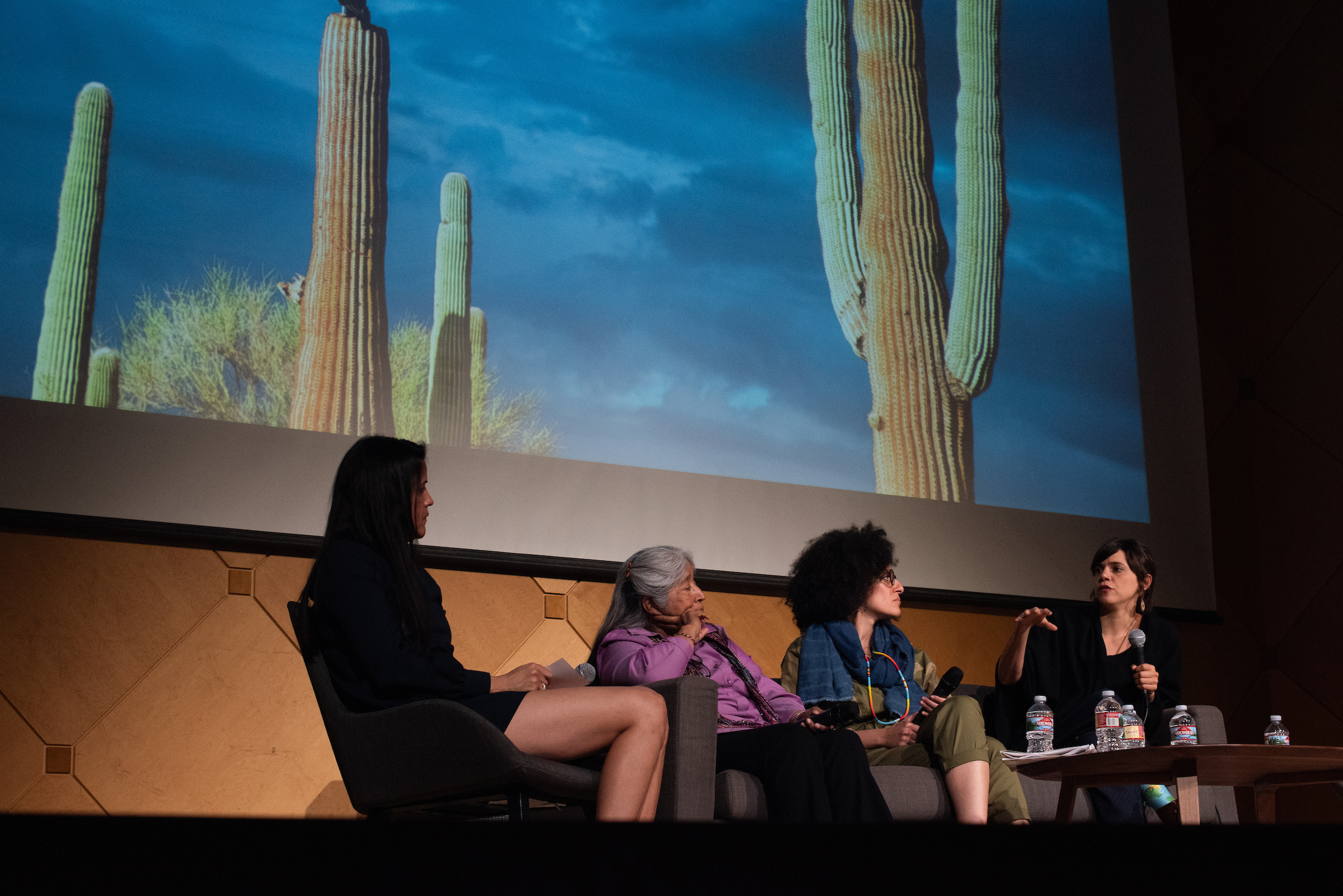The energy at Arizona State University's Katzin Concert Hall on Thursday night was mostly celebratory, sometimes solemn and decidedly female.
The university’s own wunderkind, MacArthur Fellow and renowned poet Natalie Diaz, served as master of ceremonies for an evening of readings, performance and discussion, all of which served to launch the Center for Imagination in the Borderlands, a brainchild of Diaz’s that she and her collaborators hope will spark inquiry, action and, ultimately, a reimagining of what America’s borderlands can be.
“I’ll ask that you consider the stories and energies of the lands we are on tonight,” Diaz said in her opening address to the audience, which had filled the hall to capacity. “What does it mean that we are here and some people are not?”
Diaz, who will serve as director of the center, thanked ASU President Michael Crow “for the energy to catalyze my own imagination,” as well as President’s Professor of indigenous education and justice Bryan Brayboy for his support.
“It’s not easy to be the body I am,” she said. “Queer, Native, Mexican, Latina, woman. It is lucky to have found ASU, that ASU found me, and that I am among these collaborators and provocateurs.”
ASU Associate Professor of English and Director of the Center for Imagination in the Borderlands Natalie Diaz addresses the audience at the center's launch event Thursday. Photo by Meg Potter/ASU Now
An impressive roster of artists rounded out the bill at Thursday’s launch event, taking the stage in the following order:
• President and CEO of United States Artists Deana Haggag, who spoke with passion about the power of art — but also how powerless we are to face today’s challenges in America and across borders without it.
• Tohono O’odham Nation Poet and MacArthur Fellow Ofelia Zepeda, who read a selection of her poems, including “In the Midst of Songs,” a sonorous tribute to the songs of indigenous peoples and the land that inspired them.
• Award-winning poet and ASU Assistant Professor of English Solmaz Sharif, who also read a selection of her poems, including the searing “Drone,” about the stark realities of life and death in a war-torn country.
• MacArthur Fellow and author of “Lost Children Archive” Valeria Luiselli and White Mountain Apache musician and National Artists Fellow Laura Ortman, who took the stage together in an impromptu collaborative performance in which Luiselli read excerpts of an untitled work in progress about the history of violence against women and the land in the U.S.-Mexico borderlands, intermittently punctuated and finally concluded by Ortman’s unorthodox instrumentals.
From left: ASU Associate Professor of English and Director of the Center for Imagination in the Borderlands Natalie Diaz; Tohono O’odham Nation Poet and MacArthur Fellow Ofelia Zepeda; President and CEO of United States Artists Deana Haggag; and MacArthur Fellow and author of “Lost Children Archive” Valeria Luiselli. Photo by Meg Potter/ASU Now
A brief interlude between Sharif and the joint performance of Luiselli and Ortman included remarks from ASU Dean of Humanities Jeffrey Cohen, who acknowledged that there is a lot of work to be done in the humanities.
“Too often in the past, humanities have functioned as a kind of country club, with all the exclusivity that entails,” Cohen said, “letting some people know they might be ‘more comfortable’ somewhere else. We need to abandon that model.”
The interlude also included a discussion between Diaz, Zepeda, Haggag and Luiselli on what imagination means — and what lands, stories and people inhabit it — in the borderlands.
“We tend to focus on what’s terrible about imagination when thinking of borderlands,” Diaz said. “Imagination can be a very terrible place … those fences ... it’s an incredible waste of the imagination.”
Her discussion with Zepeda, Haggag and Luiselli explored what might be possible if we were to imagine differently.
“For centuries, we have all lived in very hierarchical institutions, all of them imagined by men,” Luiselli said. “Churches, universities … congresses. And there’s a very vertical relationship of power in those imagined structures, and I think that the way I am trying to re-understand my work and everyday life is precisely against that idea … and in finding more fluid and horizontal ways of reimagining how we constellate, how we discuss, how we think in communities and, therefore, how we produce whatever it is that we produce.”
The launch event itself seemed a meta confirmation of Luiselli’s sentiments.
“There is a way of Mojave thinking where we say, ‘It’s been dreamed,’” Diaz said. “It doesn’t mean you fell asleep and a vision came to you. It means there are things set in motion that we have yet to arrive at. … This idea of collaboration is one of the ways we’re trying to arrive there.”
Other ways the center plans to work toward arriving at its goals remain to be seen. However, Diaz feels its location makes it uniquely suited to doing so.
“Arizona is a crucible for the many questions we find ourselves asking locally, nationally and throughout the world,” she said. “Arizona and ASU are unique spaces with incredible capacities to broaden these conversations because Arizona is a place of tension that necessitates the kind of thought capable of influencing and catalyzing the futures we believe we deserve. At ASU in particular, we understand that our future is now.”
Top photo: White Mountain Apache musician and National Artists Fellow Laura Ortman performs in the Katzin Concert Hall on ASU's Tempe campus during the launch of the Center for Imagination in the Borderlands on Thursday. Photo by Meg Potter/ASU Now
More Arts, humanities and education

ASU professor's project helps students learn complex topics
One of Arizona State University’s top professors is using her signature research project to improve how college students learn science, technology, engineering, math and medicine.Micki Chi, who is a…

Award-winning playwright shares her scriptwriting process with ASU students
Actions speak louder than words. That’s why award-winning playwright Y York is workshopping her latest play, "Becoming Awesome," with actors at Arizona State University this week. “I want…

Exceeding great expectations in downtown Mesa
Anyone visiting downtown Mesa over the past couple of years has a lot to rave about: The bevy of restaurants, unique local shops, entertainment venues and inviting spaces that beg for attention from…




